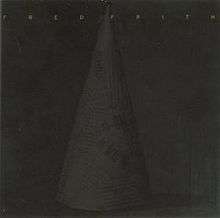Eye to Ear II
Eye to Ear II is a studio album by English guitarist, composer and improvisor Fred Frith. It is a collection of film music composed and performed by Frith, and is the second of three Eye to Ear albums dedicated to his work for short films. It was recorded in Germany and the United States between 1997 and 2003.
| Eye to Ear II | ||||
|---|---|---|---|---|
 | ||||
| Studio album by | ||||
| Released | 2004 | |||
| Recorded | 1997, 2001, Germany 2002–2003, United States | |||
| Genre | Experimental rock | |||
| Length | 47:24 | |||
| Label | Tzadik (US) | |||
| Producer | Fred Frith | |||
| Fred Frith chronology | ||||
| ||||
| Music for Film series chronology | ||||
| ||||
| Review scores | |
|---|---|
| Source | Rating |
| AllMusic | |
The music on Eye to Ear II appeared in the following films:
- Gambling, Gods and LSD (2002) by Peter Mettler
- Returning Home (2003) by Andy Abrahams Wilson
- Hirschen Mit Goldenen Hufen by Petra Mäussnest
- Sideshow by Kristin Varner
A modified version of the track "Gambling, Gods and LSD" also appeared on the soundtrack of the film of the same name, Gambling, Gods and LSD (2003) by various artists.
Track listing
All tracks by Fred Frith except where noted.
- "Sideshow 1" – 2:07
- "Gambling, Gods and LSD" – 14:19
- "Sideshow 2" – 2:26
- "Hirschen Mit Goldenen Hufen" – 7:53
- "Sideshow 3" – 2:19
- "Returning Home: Wood and Water" – 8:34
- "Returning Home: The Wind" (Frith, Wu Fei) – 4:11
- "Returning Home: Straw Dance" – 3:17
- "Sideshow 4" – 2:18
Personnel
- Fred Frith – guitars, bass guitar, piano, keyboards, violin, accordion, ocarina, kalimba, drum samples, Mobius instruments, toys, low-grade sound effects, voice
- Gail Brand – trombone (5)
- Heather Heise – accordion (6-8)
- Wu Fei – gu zheng (6-8)
- Anne Hege – voice (6-8)
- Tracks 1,3,5 and 9 recorded at Guerrilla Recordings, Oakland, United States, January–February 2002
- Track 2 recorded at Jankowski Studio, Esslingen, Germany, July 2001
- Track 4 recorded at Ludwigsburg Film Akademie, Ludwigsburg, Germany, 1997
- Tracks 6-8 recorded at Mobius Music, San Francisco, United States, January 2003
- Myles Boisen – engineer
- Oliver di Cicco – engineer, instrument design, instrument technician
- Peter Hardt – engineer, compilation, editing
- Scott Hull – mastering
- Fred Frith – audio production, compilation
- Kazunori Sugiyama – associate producer
- John Zorn – executive producer
- Heike Liss – photography
- Heung-Heung "Chippy" Chin – design
gollark: It would be hard to use it without electricity, yes.
gollark: In the meantime you can… probably use an oven, microwave or macrowave somewhere else?
gollark: Just buy your own electrons. Become independence or something.
gollark: Er, check out a JS library called regl?
gollark: WebGL.
References
- Westergaard, Sean. "Eye to Ear II". AllMusic.com. Retrieved 26 July 2018.
External links
This article is issued from Wikipedia. The text is licensed under Creative Commons - Attribution - Sharealike. Additional terms may apply for the media files.